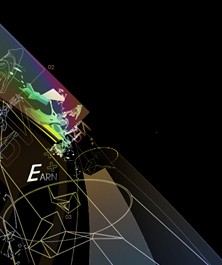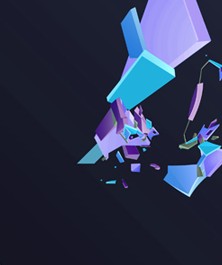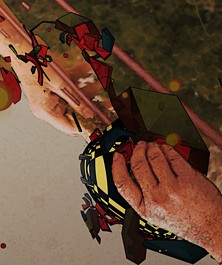Artist Interviews
- XXXI Gabriel Simonds
- XXX Vigan Tafili
- XXIX Parker Gibson
- XXVIII Courtney Wooster
- XXVII Brandon Spahn
- XXVI ricardo juarez
- XXV Daniel Kong
- XXIV Willis Kingery
Spotlight
 Desolate
by P90
View image
Desolate
by P90
View image Support Evoke
The Interview
Guilherme Damasceno, also known as Anesthesya or relove, is the youngest artist to be featured on Evoke. And he is well deserving of his feature for this milestone release.
With a unique, knockout style, Guilherme has paved his own way in the world of digital art. It is with greatest pleasure that I bring you this interview, looking into the mind of this creative, innovative artist.
Ted Yavuzkurt aka Revenant Prime
Ted Yavuzkurt:
Alright, to start off, as I always do, tell me about yourself.
What's your name, where do you come from, and so on. And tell me one random fact about yourself.
What's your name, where do you come from, and so on. And tell me one random fact about yourself.
Guilherme Damasceno:
My complete name is Guilherme Gonçalves Damasceno Moreira, but I just sign as Guilherme Damasceno. A proud Brazilian, I'm 16 and an art lover. Since I was 12 I followed digital art forums, started making signatures and tags, discovered DeviantArt and then Evoke (2006). Me and Elijah were friends and then he joined the staff and I got into the group.
Currently I'm freelancing and working at a graphics store - small business - just designing folders, flyers and printable media.
Currently I'm freelancing and working at a graphics store - small business - just designing folders, flyers and printable media.
Ted Yavuzkurt:
Right now, at the age of 16, you're the youngest artist to be featured by Evoke. In ten years, do you still see yourself as an artist? Where do you plan to go with your talent in digital art?
Guilherme Damasceno:
Lots of new things are happening to me in my life at the moment. In 10 years I might be dead (lol), but I really want to follow the digital design thing, and that may look good but in fact it isn't. Digital artists in Brazil (especially abstract artists) don't get the feedback they deserve here, so most of them go to Europe, the US and good art schools in the world. I wish I could go to Madrid to study art and stuff, but I'm not that keen on the idea of leaving my homeland with my dad, mother and sister here. So my main goal is get into college and study Law, work with my dad and design in my free time (believe me, I really do have free time).
Ted Yavuzkurt:
So Europe and the US are the ideal places to be for Digital Artists in your opinion?
Guilherme Damasceno:
(Damn that's hard)
Guilherme Damasceno:
No. You can be a digital artist anywhere. But the point is that in Brazil, unfortunately, when you decide to follow a career, you must put the money in first place (if you don't wanna feel hungry, of course). I know loads of really amazing artists (I mean REALLY AMAZING artists) that get low bucks for amazing jobs, and they could be doing a lot better getting more money in the US and Europe, and then they would be making better stuff because the required level is higher when you pay higher amounts. That will bring better equipment for the artist and for the Digital Art. But "US" and "Europe" were just examples, haha.
Ted Yavuzkurt:
I see, so artists can potentially thrive anywhere, just some places give more...motivation if you will.
Do you think that one can develop artistic talent? Or is it purely innate? (Are artists born or are they made?)
Do you think that one can develop artistic talent? Or is it purely innate? (Are artists born or are they made?)
Guilherme Damasceno:
Everybody can turn into a talented artist. The art isn't hereditary, lol. If you really want to be good, you are good. Being an open-minded person is a great step into it. And the two main points: you must know you can't hit perfection and you must try to hit it in each art work you make, no exception.
Ted Yavuzkurt:
Now concerning purely yourself as an artist, where do you get your inspiration?
Does it come from music, other artists, where?
Does it come from music, other artists, where?
Guilherme Damasceno:
That's a really difficult question, haha. I can get inspired at random, but most of it I get from music. I get some inspiration from artists too: David Garvin, Marcelo Coelho and other great artists that I've been watching since I began art. Some of my pieces are inspired by books and feelings that are going on at the moment I'm designing.
Ted Yavuzkurt:
Your style is one of the most unique I've seen in awhile. You combine all sorts of colors and shapes to create some very vibrant works.
How did you develop this style?
How did you develop this style?
Guilherme Damasceno:
This style is a mix between some styles I've been seeing and loving. The base of it is making 3D-looking shapes in Illustrator and Photoshop. It's a mix between some of my old styles: the blends and the "Origamis". I spent some time developing this style just with myself (it's the first time I'm submitting stuff like this), and I really hope you guys like it!
Ted Yavuzkurt:
We love it.
Now for the million dollar question that I'm sure EVERY artist wants an answer to.
How does one go about developing a style? How does an artist define oneself so that someone can look and say "that's so-and-so's work."
Now for the million dollar question that I'm sure EVERY artist wants an answer to.
How does one go about developing a style? How does an artist define oneself so that someone can look and say "that's so-and-so's work."
Guilherme Damasceno:
Well, my answer may look weird, but style comes from and with you. The style you develop is a reflection of what you are, and a style change may mean a change in your being. You develop a style with time - and then, after a while, people will notice that work was made by you. Of course this is not the only point - composition and concept really do define an artist; one of the most important factors is the ideology - I mean the goal you've got when you make a piece. That's what makes every artist unique.
Ted Yavuzkurt:
Ok, so concerning you as an artist, what tools do you use to create your works?
Guilherme Damasceno:
I use Adobe Photoshop 7 and Adobe Illustrator CS. I don't know the tools of them in depth. In Illustrator, I'm a lover of the pencil tool - the shapes look a lot better with it; in Photoshop, I'm always abusing the marquee, lasso and gradient tools. I also have a 6"x8" tablet, but I don't use it very much - I prefer my (old) Microsoft Comfort 3000. My computer isn't that good - currently I'm designing on my sister's (lol), and it's pretty good because it's my old PC and there are some files of mine remaining (Illustrator files), which I can use to make new stuff based off of them. Ambient tools are a quiet lounge with music and good food.
Ted Yavuzkurt:
Ahh, so in this quiet, calm environment, tell me about your workflow. How do you go from an idea to a finished product? Do you do concept sketches or just dive right in? Are you aware of the fact that you are working or do you just get "into the zone?"
Guilherme Damasceno:
Lol, I just "get into the zone". I live with my mother and my sister; they go outside a lot, so I'm always in a quiet environment.
About the idea to get to a finished product, that's weird - I get the idea when the program is opened. Sometimes I work with some sketches I make in classes (often math, hehe), but most of the time I dive right in. My art is spontaneous, and I really don't know that's a good or a bad thing.
About the idea to get to a finished product, that's weird - I get the idea when the program is opened. Sometimes I work with some sketches I make in classes (often math, hehe), but most of the time I dive right in. My art is spontaneous, and I really don't know that's a good or a bad thing.
Ted Yavuzkurt:
Well being spontaneous has certainly led to you creating some top notch works, so I'd have to say it's a good trait.
Let's analyze one of your works. Bubblegum is what I'm looking at right now. About how long did it take you to make this, and how did you do it?
Let's analyze one of your works. Bubblegum is what I'm looking at right now. About how long did it take you to make this, and how did you do it?
Guilherme Damasceno:
Bubblegum is a very meaningful piece for me, because it is my first piece in my current style. It's not that difficult to make something like it - I scrap some composition in Adobe Illustrator and then I work with shapes, more composition, colors, gradient and some postwork. I don't know how long I took to make it, my mind's gone completely blank, but it wasn't fast - I made it in two days because I was just getting into the style.
Ted Yavuzkurt:
I could tell it was a milestone piece; you've been refining your style since then.
As far as art is concerned, do you enjoy doing collaborative works? Is art a collaborative discipline to you or do you prefer to work solo?
Guilherme Damasceno:
I've got a thing with collaborative stuff: I just don't feel like brushing over a 3D render or vectorized people, so I always try to add my own stuff and style to the piece. That doesn't mean I don't like collabs, because I really enjoy them. It's so nice to make something and send to a person and expect a great effort, or get a nice file with some new techniques for you. It's nice for both sides of the collaboration in my opinion.
Ted Yavuzkurt:
So if you are in favor of collaborative work, do you see all the online art groups that have emerged as a good thing or a bad thing for the art community as a whole? Many people argue that art groups merely encourage everyone to have one style, whereas others say they develop the strengths of all artists.
What is your take on the issue?
What is your take on the issue?
Guilherme Damasceno:
Well, I think the main goal of an artgroup is not merging works, as lots of people think. I think I'm for the second one - art groups not only enhance one's strengths, but also improve one's weaknesses. That's good because you can improve the points you're missing.
Art group works as a motivation, too - lots of people aim to join one so they get motivated for art and get better. That's what happened with me last year, when I decided to apply to Evoke: I was making a simple style of abstracts in PS and suddenly I learned how to make blends and a nice composition in Illustrator. That's quite weird, huh?
Art group works as a motivation, too - lots of people aim to join one so they get motivated for art and get better. That's what happened with me last year, when I decided to apply to Evoke: I was making a simple style of abstracts in PS and suddenly I learned how to make blends and a nice composition in Illustrator. That's quite weird, huh?
Ted Yavuzkurt:
Not weird at all, you learned as part of the collective mind of Evoke ;]
Anyway, before we wrap this up, give me a quote or a statement you live by. It can be anything.
Anyway, before we wrap this up, give me a quote or a statement you live by. It can be anything.
Guilherme Damasceno:
Well, I've got two for you. The first one is: you always can do it, just don't give up; make your shirt sweaty, but never stop trying. As I said before, try to hit perfection always, despite it being impossible.
And the second and most important one: don't forget to eat!
And the second and most important one: don't forget to eat!
Ted Yavuzkurt:
Haha, how true.
Is there anything else you would like to say before we finish this off?
Is there anything else you would like to say before we finish this off?
Guilherme Damasceno:
Yes. I must thank you, Ted, for this interview (it's my first one!), and Evoke's staff and members for the feedback. I'm working on some personal projects, so expect more art and let's rock Evoke 13!
Ted Yavuzkurt:
Amen, a pleasure to talk with you.





